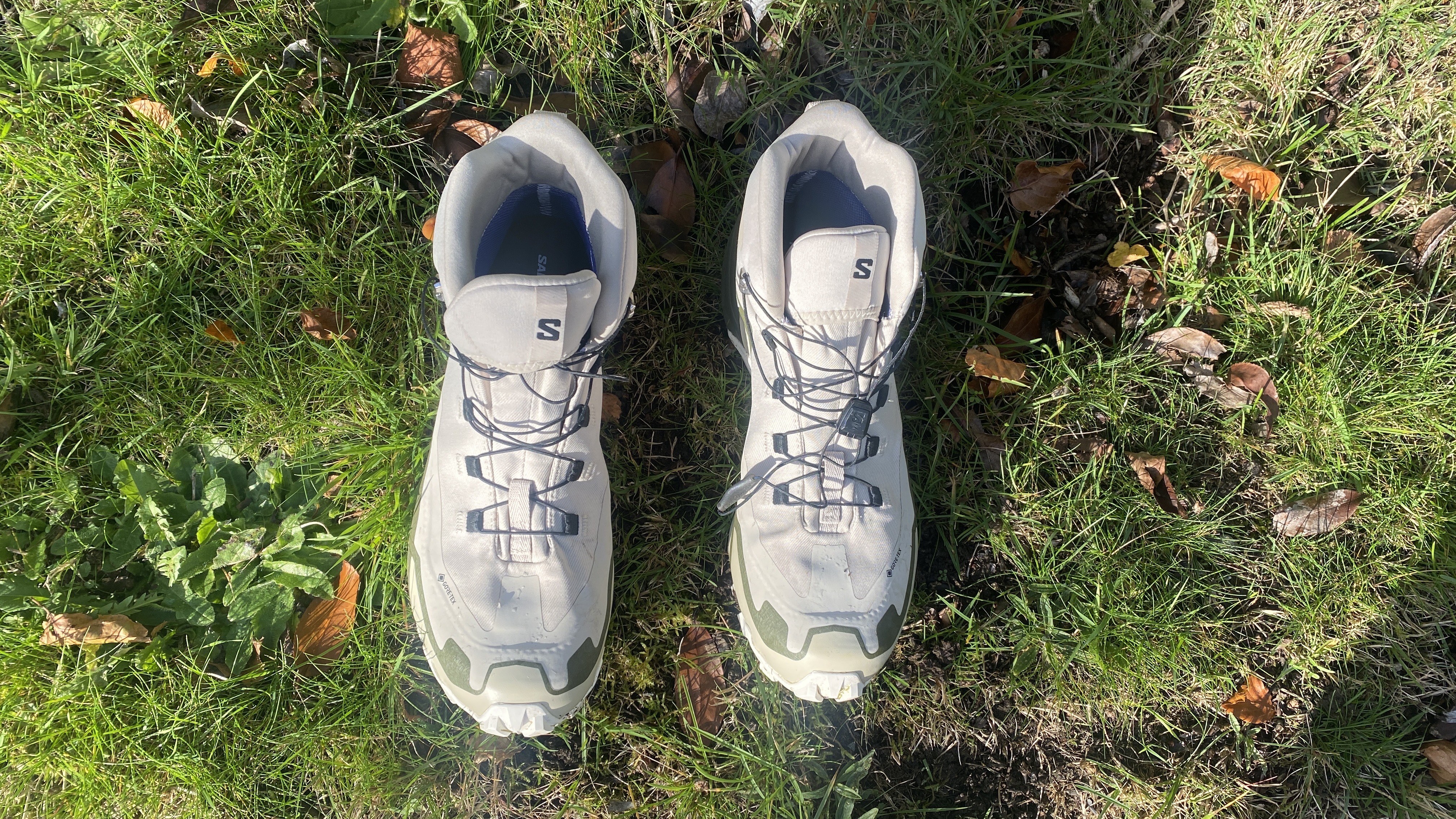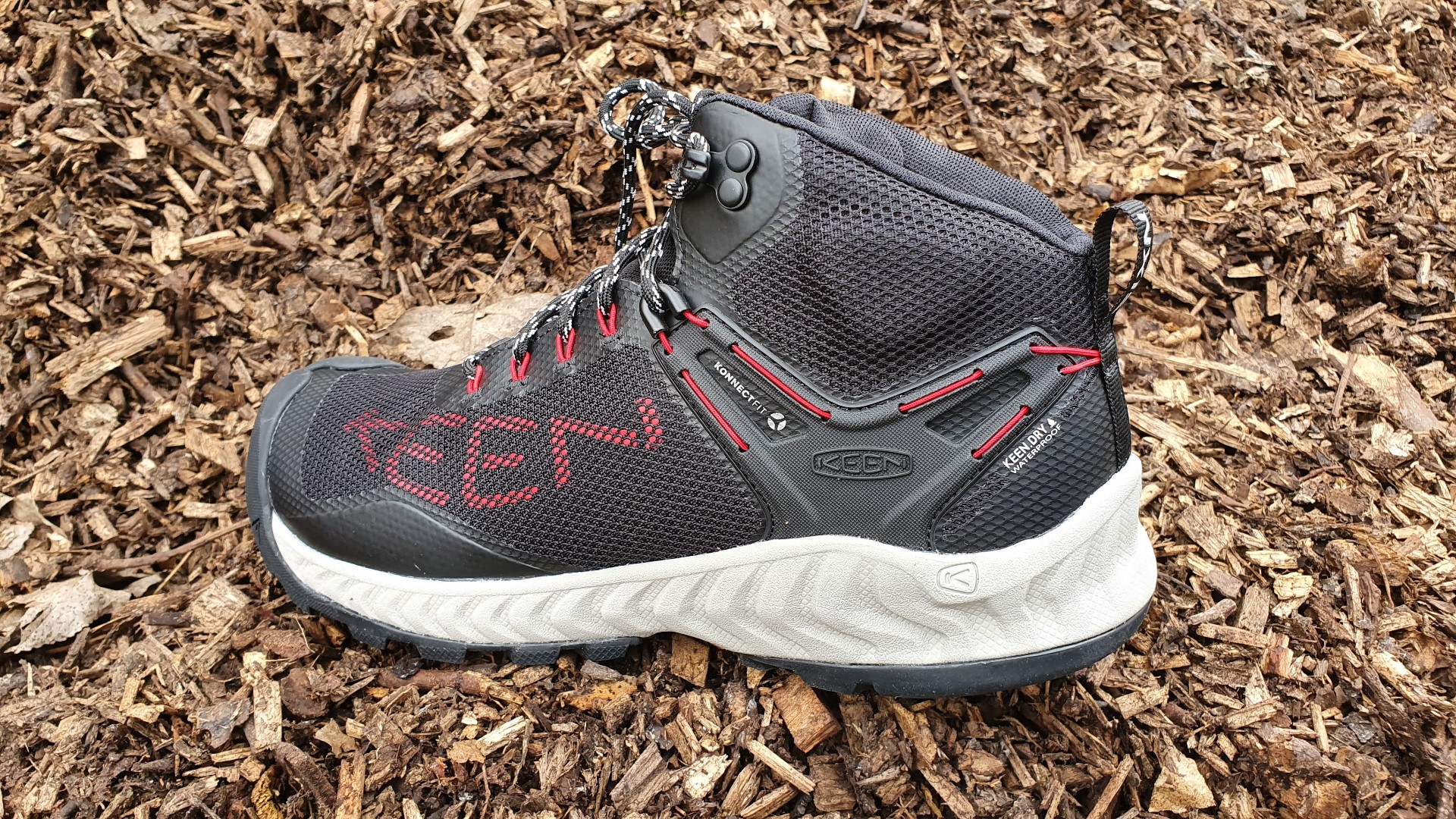
Long gone (thankfully) are the days when all hiking boots were fashioned from thick leather and heavy rubber, and you had to break them in for months before they were supple enough to wear out on the hills and trails without crippling you with blisters.
These days, the best hiking boots for men and best women's hiking boots are made with a smart mixture of materials, often (but not always) still including leather and suede but also employing high-performing, lightweight and long-lasting synthetic fabrics that make the footwear soft and comfortable straight out of the box.
Typically, this more sophisticated upper is backed by a breathable, waterproof membrane (Gore-Tex or similar) to make them weatherproof and supported by a technically advanced midsole and a grippy outsole.
But there is more – much, much more – to a really good hiking boot than this simplistic description suggests, so here we’re going to break it down properly.
Hiking boot anatomy
Chassis

Otherwise known as ‘the upper’, this refers to the entire top section of the boot, the main part of which is built around a ‘last’ (basically one of those wooden foot-shaped things you see in old cobbler’s shops, but slightly more modernised).
The chassis has various components that we will detail below, but its main job is to hold the foot securely and comfortably, minimizing internal movement, reducing the risk of twists, falls and other injury-creating incidents, and providing protection from the elements and the outside world in general.
Numerous materials can go into making the chassis, from leather and suede to synthetics (increasing amounts of which are either recycled or made from eco-friendly materials than was previously the case, as seen in the Ariat Moresby).
Collar

The very top part of the boot, the collar might stop at the ankle (on a low-cut boot), just above the ankle joint (on a ‘mid’ height boot), or several centimetres above the ankle (on a high boot).
Boots with a low collar are commonly referred to as hiking shoes, while mid-height collars are very commonly used on the sort of general day-walking and trekking boots worn by the majority of people, such as the Berghaus Explorer Trek.
Higher collars are typically seen on more technically advanced boots designed for alpine use and/or wearing during the depths of winter, such as the Scarpa R-Evo GTX.
The primary role of the collar is to supply support and confidence, especially around the ankle area when tackling tricky terrain, and particularly if you are carrying any real weight in a hiking backpack.
Pull loop/Pull tab

Found on the back of the collar, above the heel, a pull loop is simply there to help you get your feet into your boots nice and easily.
Membrane
Whatever it’s made of, the entire upper of a good hiking boot will be lined with a waterproof, breathable membrane, such as Gore-Tex, to keep your best walking socks dry, while still letting your feet breathe.
Reliable waterproofing is a crucial feature for hiking boots and shoes (unlike trail running shoes) because you’re more likely to be wearing them for a lot longer each day, and hikers move slower and are, therefore, more susceptible to getting cold.
Lining and insulation

Most hiking boots will use a soft-feel breathable inner material to supply comfort to your feet while not impacting on the performance of the membrane and other technical fabric employed in the boot. Boots designed specifically for winter should have extra insulation, like the Keen Revel IV Polar High.
Tongue
Most modern hiking boots now have a gusted tongue that’s integrated into the main chassis, so there is no gap for grit or other debris to get through. This also maintains the waterproof integrity of the boot (there wouldn’t be much point in making the boot waterproof above the heel if water seeped in through the tongue as soon as you trod in an ankle-deep puddle or stream). Some – like the Arc'teryx Norvan Nivalis GTX – even employ an in-built gaiter to improve this protection from the elements.
Laces

The majority of hiking boots still feature fairly traditional laces, usually threaded through a mixture of eyelets or D-rings (at the bottom of the tongue) and speed hooks at the top, closer to the collar, which helps you get a good tight fit, but still get the boot on and off quickly.
Some brands, however, especially those that focus on really lightweight footwear for fastpacking and speed hiking – have experimented with quick lace, cables and boa-style systems, as seen on the Salomon Cross Hike 2.
Heel cup

A crucial component of a hiking boot upper is the heel cup. To avoid problems such as blisters and blackened toenails, you need your boots to fit perfectly, achieving a secure hold that prevents your feet from sliding around inside the chassis. After selecting the right size, much of this comes down to a good heel cup and locking system, such as the design on Keen’s NXIS Evo boots.
Toe box

This is the area at the front of the boot where your toes live. Of course, it is. One of the main considerations to factor in when choosing the best hiking boots for you is comfort and a lot of that boils down to whether your toes have room to spread (good) or if they feel cramped (bad). If you have broad feet or bunions, then look for a brand that offers boots with a wide fit as well as a regular fit, like the Lowa Renegade.
Insole

Often sold with the boot – but usually removable and interchangeable so you can swap in an alternative footbed, insert or orthotic to suit your personal needs – insoles help people customise the interior fit of the boot to suit their feet, and they can help reduce discomfort caused by biomechanical foot issues such as high arches, pronation and plantar fasciitis.
The Haglofs Duality AT2 boots even come with interchangeable inserts (pictured above) that sit somewhere between an insole and midsole and can be swapped according to whether you’re hiking in the hills and mountains or taking on flat terrain.
Midsole

Suspension for your legs, the midsole on a good hiking boot absorbs and dampens some of the impact that happens when you repeatedly put one foot after the other for many hours and multiple miles, easing the stress placed on your knees, ankles and feet.
Typically constructed with ethylene-vinyl acetate (EVA) foam or polyurethane (PU), the best midsoles allow some trail feedback while still providing some cushioning for your feet, and even supplying a bit of bounce to help propel you forwards, as seen in the excellent Adidas Terrex Free Hikers.
There are barefoot hiking boots out there, like the Vivobarefoot Tracker Decon FG 2, which have little to no midsole at all, but models from other brands, such as the Hoka One One Anacapa Low GTX, use large, chunky midsoles, dispensing with all ground feel in the process. Most hiking boots strike a happy medium, as seen in models like the Jack Wolfskin Force Striker Texapore.
Shank

Typically made from either nylon or metal (thin steel), the shank is a semi-rigid insert that extends along the length of the boot beside (or within) the midsole.
It serves a couple of purposes, protecting your sole from puncture wounds and bruising caused by sharp objects underfoot (like a rockplate in good trail-running shoes) and supplying a degree of rigidity across the boot.
More technical mountaineering boots need to be quite rigid to support your foot when edging around rocks and using crampons, as seen in the ace Arc’teryx Acrux LT GTX.
Rand
This is a strip of protective reinforcement that runs around the lower edge of the boot chassis, just above the sole. Usually made from rubber, it works a bit like a bumper and can save you from injury from sharp sticks and stones while also shielding the less robust materials used in the chassis.
Toecap

Like the rand, the toecap is a protective bumper found – you guessed it – on the outside of the boot by your toes. It can save you from stubbing injuries and enables you to do things like kick snow steps without damaging your pinkies. More hardcore boots designed for use in technical terrain – like the Mammut Taiss Light Mid GTX – will have a more substantial rand and toecap, whereas boots built to be light and flighty, such as the Inov-8 Roclite G 345 GTX, virtually dispense with these features to keep the weight down.
Outsole

A crucial consideration when choosing any form of outdoor footwear – from decent wellies to functional work boots, but especially when considering hiking hooves – is the part of the boot that provides the all-important features of grip, traction and braking control.
Made from a rubber compound, hiking boot outsoles feature lugs and/or chevrons that work like studs to grip the surface of whatever terrain you are traversing to prevent you from sliding over.
These lugs vary in depth (usually between 3mm and 5mm), and they’re arranged in various patterns to provide traction when you’re moving forward and upwards and braking control when you are descending on slippery, muddy or icy terrain.
Beware: Lug patterns that are too closely clustered can collect heavy mud, which will massively increase the weight of your boots; conversely, wide-spaced aggressive (deep) lug patterns can be uncomfortable to walk on when the surface is hard-packed or sealed.
Many brands use outsoles produced by specialists such as Vibram, as seen on the Danner Mountain 600. For a very different take on the traditional outsole, offering plenty of speed but less bite, check out the On Cloudrock Waterproof hiking boots. On more technical ‘B2’ boots made for adventures in icy mountain ranges, the outsole will feature crampon welts, which are rubber protrusions at the heel and the toe for fixing on the corresponding ‘C2’ crampons.
Lugs

There are so many variations and things to weigh up here that lugs demand their own heading. The deeper the lug, the more aggressive and grippy the sole is on softer surfaces such as mud and snow, but consider how much you need this level of grip because chunky outsoles are also heavy.
The softer the rubber used in the lugs, the more grippy the boot will be on rocky surfaces, but the quicker those lugs will wear out. Harder compounds can last for decades but can be treacherously skiddy on smooth, wet rocky surfaces.
In recent years, British brand inov-8 has pioneered the use of graphene (a crystalline carbon highly regarded for its incredible toughness and longevity) in the outsoles of their hiking footwear, such as the excellent Roclite Pro G 400 GTX boots and the Rocfly G390 (which even features graphene in the midsole).







